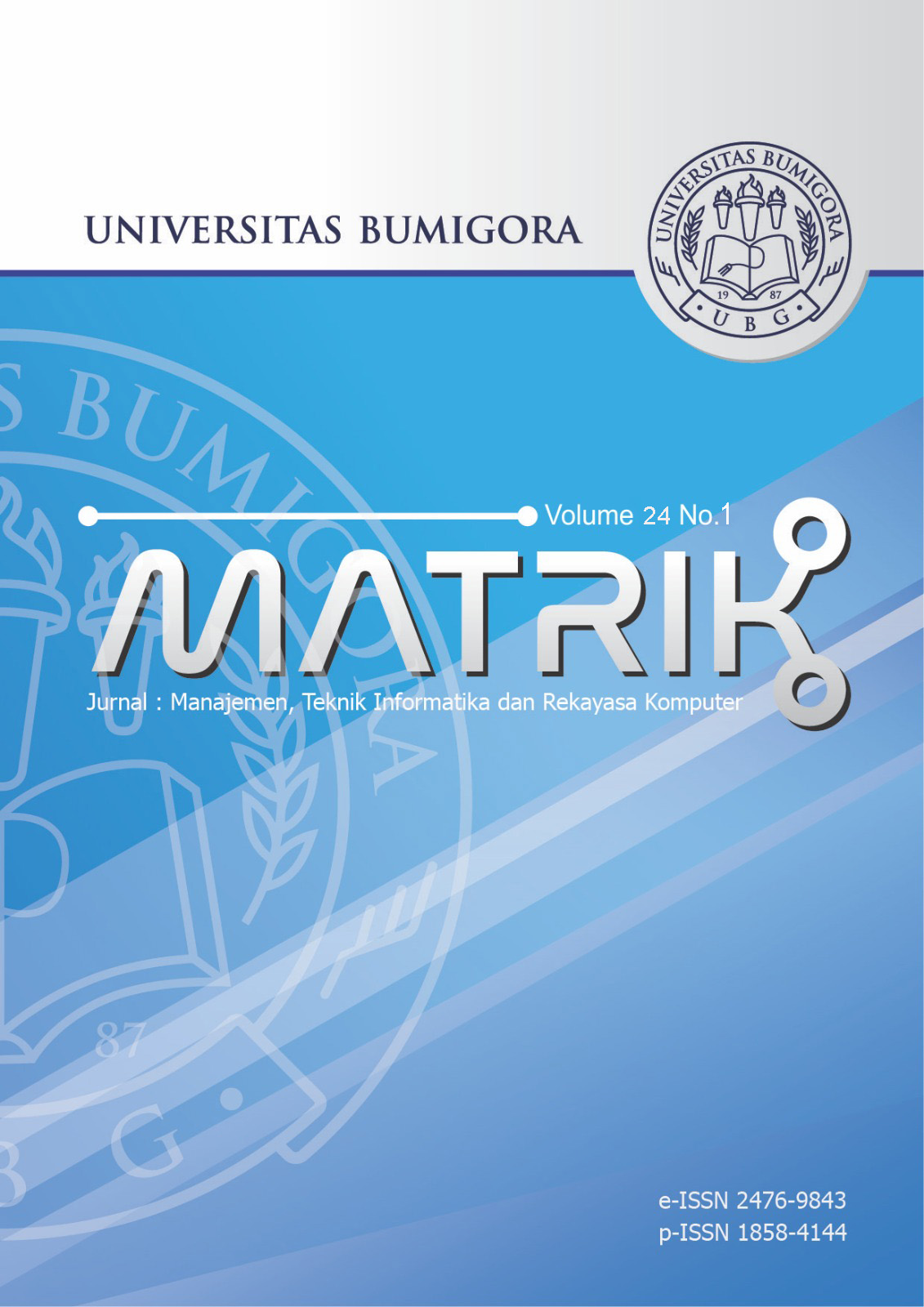Integration of Deep Learning and Autoregressive Models for Marine Data Prediction
DOI:
https://doi.org/10.30812/matrik.v24i1.4032Keywords:
Algorithm, Correlation, Deep Learning, Mean Absolute ErrorAbstract
Climate change and human activities significantly affect the dynamics of the marine environment, making accurate predictions essential for resource management and disaster mitigation. Deep learning models such as Long Short-Term Memory excel at capturing non-linear temporal patterns, while autoregressive models handle linear trends to improve prediction accuracy. This aim study predicts sea surface temperature, height, and salinity using deep learning compared to Moving Average and Autoregressive Integrated Moving Average methods. The research methods include spatial gap analysis, temporal variability modeling, and oceanographic parameter prediction. The relationship between
parameters is analyzed using the Pearson Correlation method. The dataset is divided into 80% training and 20% test data, with prediction results compared between Long Short-Term Memory, Moving Average, and Autoregressive models. The results show that Long Short-Term Memory performs best with a Root Mean Squared Error of 0.1096 and a Mean Absolute Error of 0.0982 for salinity at 13 sample points. In contrast, Autoregressive models produce a Root Mean Squared Error of 0.193 for salinity, 0.055 for sea surface height, and 2.504 for sea surface temperature, with a correlation coefficient 0.6 between temperature and sea surface height. In conclusion, the Long Short Term Memory model excels in predicting salinity because it is able to capture complex non-linear patterns. Meanwhile, Autoregressive models are more suitable for linear data trends and explain the relationship between parameters, although their accuracy is lower in salinity prediction. This approach
Downloads
References
[2] J. Shi, M. Jain, and G. Narasimhan, “Time Series Forecasting Using Various Deep Learning Models,†World Acad. Sci. Eng. Technol. J. Comput. Syst. Eng. Vol 16, No 6, 2022, doi: https://doi.org/10.48550/arXiv.2204.11115.
[3] J.-J. F. A.- Andreu-Francisco Javier Francisco Javier López, Morales-Juan Antonio López, Guillen-Zaida Hernández, Rodrigo-Juan Antonio Carrero, Alcaraz-Marta Sánchez, “Deep Learning-Based Time Series Forecasting Models Evaluation for the Forecast of Chlorophyll a and Dissolved Oxygen in the Mar Menor,†J. Mar. Sci. Eng., vol. 11, no. 7, 2023, doi: https://doi.org/10.3390/jmse11071473.
[4] A. W. Saputra, A. P. Wibawa, U. Pujianto, A. B. Putra Utama, and A. Nafalski, “LSTM-based Multivariate Time-Series Analysis: A Case of Journal Visitors Forecasting,†Ilk. J. Ilm., vol. 14, no. 1, page. 57–62, 2022, doi: https://doi.org/10.33096/ilkom.v14i1.1106.57-62.
[5] E. M. C. Wattimena, A. Annisa, and I. S. Sitanggang, “CO and PM10 Prediction Model based on Air Quality Index Considering Meteorological Factors in DKI Jakarta using LSTM,†Sci. J. Informatics, vol. 9, no. 2, page. 123–132, 2022, doi: https://doi.org/10.15294/sji.v9i2.33791.
[6] T. Shering, E. Alonso, and D. Apostolopoulou, “Investigation of Load, Solar and Wind Generation as Target Variables in LSTM Time Series Forecasting, Using Exogenous Weather Variables,†Energies, vol. 17, no. 8, 2024, doi: https://doi.org/10.3390/ en17081827.
[7] H. Oukhouya and K. El Himdi, “Comparing Machine Learning Methods—SVR, XGBoost, LSTM, and MLP— For Forecasting the Moroccan Stock Market,†hal. 39, 2023, doi: https://doi.org/10.3390/IOCMA2023-14409.
[8] C. Kang; and Z. Zhang, “Application of LSTM in Short-term Traffic Flow Prediction,†in 2020 IEEE 5th International Conference on Intelligent Transportation Engineering (ICITE), 2020, hal. 98–101. doi: https://doi.org.10.1109/ICITE50838.2020.9231500.
[9] B. K. Hidayatullah, M. Kallista, C. Setianingsih, P. S1, and T. Komputer, “Prediksi Indeks Standar Pencemar Udara Menggunakan Metode Long Short-Term Memory Berbasis Web (Studi Kasus Pada Kota Jakarta),†e - Proceeding Eng., vol. 9, no. 3, page 1247–1255, 2022, doi: https://doi.org/10.34818/eoe.v9i5.18452.
[10] S. Z. Jinhui Wang, Yu Zhou, Lei Zhuang, Long Shi, “A model of maritime accidents prediction based on multi-factor time series analysis,†J. Mar. Eng. Technol., vol. Volume 22, no. Issue 3: Navigation and Safety, page. 153–165, 2023, doi: https:// doi.org/10.1080/20464177.2023.2167269.
[11] M. Kim, H. Yang, and J. Kim, “Sea surface temperature and high water temperature occurrence prediction using a long short-term memory model,†Remote Sens., vol. 12, no. 21, page 1–21, 2020, doi: 10.3390/rs12213654.
[12] M. A. Litzow, M. J. Malick, T. Kristiansen, B. M. Connors, and G. T. Ruggerone, “Climate attribution time series track the evolution of human influence on North Pacific sea surface temperature,†Environ. Res. Lett., vol. 19, no. 1, 2024, doi: 10.1088/1748-9326/ad0c88.
[13] J. Chen, I. G. C. Ashton, E. C. C. Steele, and A. C. Pillai, “A Real-Time Spatiotemporal Machine Learning Framework for the Prediction of Nearshore Wave Conditions,†Artif. Intell. Earth Syst., vol. 2, no. 1, page. 1–14, 2022, doi: 10.1175/aies-d-22-0033.1.
[14] U. Tangke and B. Senen, “Distribution of sea surface temperature and chlorophyll-a concentration its correlation with small pelagic fish catch in Dodinga Bay,†IOP Conf. Ser. Earth Environ. Sci., vol. 584, no. 1, page. 1–8, 2020, doi: 10.1088/1755-1315/584/1/012020.
[15] M. Suhermat, “Pemodelan Kesesuaian Habitat Ikan Cakalang Menggunakan Penginderaan Jauh di Perairan Selatan Jawa Barat-Banten,†J. Ilmu Lingkung., vol. 22, no. 3, page. 667–671, 2024, doi: https:/doi.org/10.14710/jil.22.3.667-671.
[16] J. Sun, H. Dong, Y. Gao, Y. Fang, and Y. Kong, “The Short-Term Load Forecasting Using an Artificial Neural Network Approach with Periodic and Nonperiodic Factors: A Case Study of Tai’an, Shandong Province, China,†Comput. Intell. Neurosci., vol. 2021, hal. 1–8, 2021, doi: 10.1155/2021/1502932.
[17] A C Dompeipen, D R Rumohoira, A S Atmadipoera, Nabil, Apriansyah, D Nugroho and N M N Natih., “Ocean Circulation and Variability in the Seram and Northern Banda Seas,†IOP Conf. Ser. Earth Environ. Sci., vol. 1350, no. 1, page. 1–15, 2024, doi: 10.1088/1755-1315/1350/1/012004.
[18] I. G. Putu, W. Paramartha, I. D. Nyoman, N. Putra, I. W. Gede, and A. Karang, “Analisis Perubahan Suhu Permukaan Laut di Wilayah Laut Flores and Sekitarnya,†J. Mar. Res. Technol., vol. 7, no. 2, page. 170–176, 2024, doi: https://doi.org/10.24843/JMRT.2024.v07.i02.p14.
[19] T. Dimri, S. Ahmad, and M. Sharif, “Time series analysis of climate variables using seasonal ARIMA approach,†J. Earth Syst. Sci., vol. 129, no. 1, page. 129–149, 2020, https://doi.org/ 10.1007/s12040-020-01408-x.
[20] S. Siami-Namini, N. Tavakoli, and A. Siami Namin, “A Comparison of ARIMA and LSTM in Forecasting Time Series,†Proc. - 17th IEEE Int. Conf. Mach. Learn. Appl. ICMLA 2018, page. 1394–1401, 2018, https://doi.org/ 10.1109/ICMLA.2018.00227.
Downloads
Published
Issue
Section
How to Cite
Similar Articles
- Michael Michael, Frenky Tanoto, Eric Wibowo, Frenky Lutan, Abdi Dharma, Pengenalan Plat Kendaraan Bermotor dengan Menggunakan Metode Template Matching dan Deep Belief Network , MATRIK : Jurnal Manajemen, Teknik Informatika dan Rekayasa Komputer: Vol. 19 No. 1 (2019)
- Ni Wayan Sumartini Saraswati, I Wayan Dharma Suryawan, Ni Komang Tri Juniartini, I Dewa Made Krishna Muku, Poria Pirozmand, Weizhi Song, Recognizing Pneumonia Infection in Chest X-Ray Using Deep Learning , MATRIK : Jurnal Manajemen, Teknik Informatika dan Rekayasa Komputer: Vol. 23 No. 1 (2023)
- Ahmad Naufal Labiib Nabhaan, Rakandhiya Daanii Rachmanto, Arief Setyanto, Characterizing Hardware Utilization on Edge Devices when Inferring Compressed Deep Learning Models , MATRIK : Jurnal Manajemen, Teknik Informatika dan Rekayasa Komputer: Vol. 24 No. 1 (2024)
- Danang Wahyu Utomo, Christy Atika Sari, Folasade Olubusola Isinkaye, Quality Improvement for Invisible Watermarking using Singular Value Decomposition and Discrete Cosine Transform , MATRIK : Jurnal Manajemen, Teknik Informatika dan Rekayasa Komputer: Vol. 23 No. 3 (2024)
- Vivin Nur Aziza, Utami Dyah Syafitri, Anwar Fitrianto, Optimizing Currency Circulation Forecasts in Indonesia: A Hybrid Prophet- Long Short Term Memory Model with Hyperparameter Tuning , MATRIK : Jurnal Manajemen, Teknik Informatika dan Rekayasa Komputer: Vol. 24 No. 1 (2024)
- Munirul Ula, Veri Ilhadi, Zailani Mohamed Sidek, Comparing Long Short-Term Memory and Random Forest Accuracy for Bitcoin Price Forecasting , MATRIK : Jurnal Manajemen, Teknik Informatika dan Rekayasa Komputer: Vol. 23 No. 2 (2024)
- Rizky Afrinanda, Lusiana Efrizoni, Wirta Agustin, Rahmiati Rahmiati, Hybrid Model for Sentiment Analysis of Bitcoin Prices using Deep Learning Algorithm , MATRIK : Jurnal Manajemen, Teknik Informatika dan Rekayasa Komputer: Vol. 22 No. 2 (2023)
- Aini Suri Talita, Aristiawan Wiguna, Implementasi Algoritma Long Short-Term Memory (LSTM) Untuk Mendeteksi Ujaran Kebencian (Hate Speech) Pada Kasus Pilpres 2019 , MATRIK : Jurnal Manajemen, Teknik Informatika dan Rekayasa Komputer: Vol. 19 No. 1 (2019)
- Angelina Ervina Jeanette Egeten, PENGARUH PEMBELAJARAN E-LEARNING DAN KEBIASAAN BELAJAR TERHADAP PENINGKATAN KOMPETENSI MAHASISWA PASCASARJANA PADA UNIVERSITAS BINA NUSANTARA , MATRIK : Jurnal Manajemen, Teknik Informatika dan Rekayasa Komputer: Vol. 16 No. 2 (2017)
- Melinda Melinda, Zharifah Muthiah, Fitri Arnia, Elizar Elizar, Muhammad Irhmasyah, Image Data Acquisition and Classification of Vannamei Shrimp Cultivation Results Based on Deep Learning , MATRIK : Jurnal Manajemen, Teknik Informatika dan Rekayasa Komputer: Vol. 23 No. 3 (2024)
You may also start an advanced similarity search for this article.


.png)












